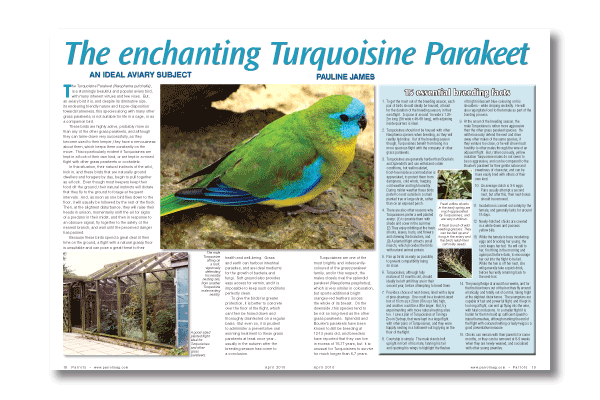The enchanting Turquoisine Parakeet - An ideal aviary subject
Pauline James
The Turquoisine Parakeet (Neophema pulchella), is a stunningly beautiful and popular aviary bird, with many inherent virtues and few vices. But, an aviary bird it is, and despite its diminutive size, its endearing friendly nature and its pre-disposition towards tameness, this species along with many other grass parakeets, is not suitable for life in a cage, or as a companion bird.
These birds are highly active, probably more so than any of the other grass parakeets, and although they can tame-down very successfully, as they become used to their keeper, they have a nervousness about them, which keeps them constantly on the move. This is particularly evident if Turquoisines are kept in a flock of their own kind, or are kept in a mixed flight with other grass parakeets or cockatiels.
In this situation, their natural instincts of the wild, kick in, and these birds that are naturally ground dwellers and foragers by day, begin to pull together as a flock. Even though most keepers keep their food off the ground, their natural instincts will dictate that they fly to the ground to forage at frequent intervals. And, as soon as one bird flies down to the floor, it will usually be followed by the rest of the flock. Then, at the slightest disturbance, they will raise their heads in unison, momentarily sniff the air for signs of a predator in their midst, and then in response to an obscure signal, fly together to the safety of the nearest branch, and wait until the perceived danger has passed.
Because these birds spend a great deal of their time on the ground, a flight with a natural grassy floor is unsuitable and can pose a great threat to their health and well-being. Grass and earth can harbour intestinal parasites, and are ideal mediums for the growth of bacteria and fungi. Soft ground also provides easy access for vermin, and it is impossible to keep such conditions perfectly clean.
Read more in the magazine…









Parrot Chat
Buyers Guides
Breeding articles